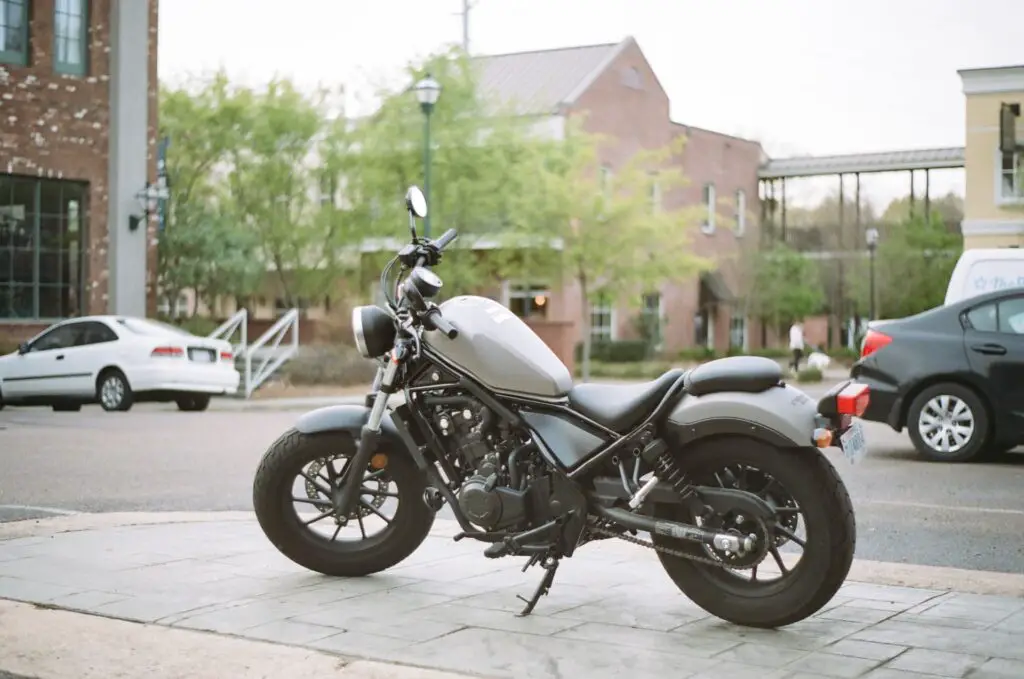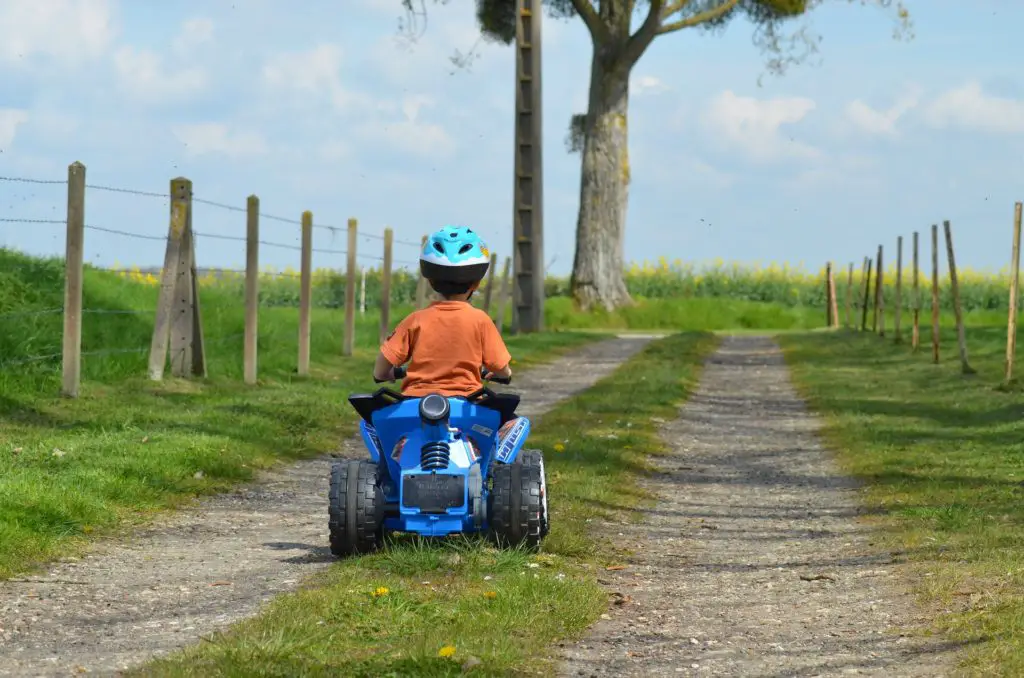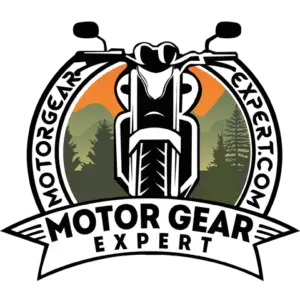Motorcycle riding: an activity for the whole family? You may love riding every chance you get, but can you ride with your children? If you’re considering adding a car seat to your motorcycle, this guide should help you think through whether or not that’s a good idea, or even a possible thing to do.
Technically, you can put a car seat on a motorcycle if you have a passenger seat or a sidecar. However, it’s generally agreed that putting a car seat on a motorcycle isn’t safe and that young children should not ride on a motorcycle until they can reach the footpegs.
For more details on child safety while riding and the dos and don’ts of riding with a carseat, keep reading through some of these common questions and things to consider.

Should you put a car seat on your motorcycle?
It is possible to put a carseat on your motorcycle. Certain models of carseat can be attached to the passenger seat of a motorcycle or secured in a sidecar.
However, just because it can be done, doesn’t mean it should. Attaching a carseat to a motorcycle just isn’t safe. No matter how securely you think you’ve attached the carseat, it could fly off in the event of a crash.
Additionally, if you have a child riding in a carseat, they are probably too small to fit a helmet properly. A helmet that is too large won’t provide adequate safety if there is an accident, and a large, heavy helmet can damage a young child’s head and neck.
The jostling and vibration of a long motorcycle ride can also damage a baby, even on the smoothest ride.
So, now that I’ve give you reasons not to ride with a baby in a carseat, I will provide a few details to at least increase safety if you insist on trying to attach a carseat to a motorcycle. The most important thing is that the carseat should include a five-point harness.
In addition, the carseat must be securely attached. A single strap holding the carseat onto the pillion won’t be enough. You need to know that the carseat will not wiggle while you ride and will not be projected off if you crash or brake abruptly.
Often carseats are placed in sidecars, but you still need to completely attach the carseat to the sidecar rather than just place it down. Even an abrupt turn or acceleration can turn a carseat into a projectile with deadly results. If you’re going to ride with a carseat, it needs to be secured.
Your child should be old enough to wear a helmet, gloves, and boots. They should be wearing a thick jacket and thick pants. If you are riding with a child of any age, it’s much safer to secure them to the pillion seat than to let them ride in front of you.
I will note that very few places have any rules about riding with children. Some areas have rules about passengers such as saying that the passenger must be able to reach the foot pegs, but in general there is no law about age limits for motorcycle riders.
Again, attaching a carseat to your motorcycle is technically possible, and in most places it is not technically illegal. However, this does not mean it’s a good idea. If you value the lives and safety of your children, you will wait to give them a motorcycle ride until they’re old.
Can you ride your motorcycle with kids?
So, taking an infant in a carseat on the motorcycle isn’t a good idea. What about riding with older children? Before 12 months, babies don’t have the muscles to support their head, so riding can be incredibly dangerous. However, what about a kid who is five years old?
The next section will talk a little more about what age makers to think about when deciding when your child can ride with you on a motorcycle. For now, I want to start by outlining many of the safety features you need to consider when riding with a kid of any age.
Helmets are non-negotiable. For your child to ride on the back of your bike, they need to be wearing a properly fitting helmet. The helmet should have a chin bar and visor, or goggles at the very least. The chin strap should be fastened and tight against your child’s neck, and they should be able to shake their head without the helmet wobbling around much.
In addition to helmets, children riding should have the same motorcycle gear that you do. They should be fitting with strong boots that go over the ankle and don’t have laces, which could get caught up in the parts of the bike.
While you probably don’t need to invest in an expensive motorcycle jacket, a thick denim or leather jacket will keep your child safer. Thick jeans are also important. Finally, your child should be wearing a thick, protective pair of gloves.
Depending on the age of your child, you may want to use a harness to secure them to the seat. It can be dangerous to trust a child to hold on during the ride, since they might get distracted or tired and loosen their grip.
If your child is old enough to hold on on their own, you can buy a specially designed belt for yourself, which has loops for a child to hold onto. This gives them a better grip and something that is easier to hold.
Finally, before you start riding, check your local laws to find out if there are any age or height restrictions. Then, take some practice rides around empty streets and at low speeds. Once you and your child are comfortable riding you can take some longer trips, but take it slow and avoid busy streets.
What age can a child safely ride a motorcycle?
Legally, the answer to this question varies state by state and country by country. Always check your local laws before riding with a child of any age.
Infants should never ride on a motorcycle. Before 12 months they don’t have the muscles to support their head and neck and will therefore suffer from the vibrations and bumps of riding. Additionally, an infant won’t be able to wear a helmet and therefore is not safe on a bike.
A toddler should also not ride a motorcycle, though if you must ride with a toddler they should be secured in a carseat with a five-point helmet and all proper motorcycle gear.
Ideally, children can ride a motorcycle only once they are tall enough that their feet can rest comfortably on the footrests. They should be able to hold on but should also be secured with a harness or belt so they don’t fall off. Children should always ride behind the driver as any normal passenger.
Riding with a child in front of you can be incredibly dangerous. You will have less control of the bike and you both will suffer worse injuries if there is an accident. Even a quick deceleration could propel the child off the bike.
If children ride the bike with you, they should be prepared in the proper gear. They should also receive safety lessons before getting on the bike, even though they won’t be driving.
It’s up to you to decide if it is safe enough to ride with a child and if your child can handle it. Ultimately, there is a significant risk in riding with a child that shouldn’t be ignored. You need to weigh the risk and the safety measures you have in place.
What is the safest way to ride a motorcycle with a passenger?
Riding with a child poses significant risk, but even riding with an adult passenger can be risky. No matter how experienced you are with riding, it’s a different experience to ride with someone else on the bike. Plus, the rider may not have any experience with motorcycles. Here are some tips to make the experience safer.
Go over some general motorcycle safety tips with the passenger. Make sure the passenger is familiar with a motorcycle. Let them know some basic safety tips and prepare them for what it will be like to ride.
Your passenger should always ride behind you on a permanent seat. A passenger in front of the driver will affect steering control and be incredibly dangerous if there’s an accident.
The passenger should wear proper gear, including a helmet that fits properly, motorcycle gloves, thick pants, a thick jacket, and boots that cover the ankles and don’t have shoelaces. Aside from the helmet, gloves and tall shoes are among the most important safety features in the event of a crash.
The passenger should be facing forward and should have somewhere stable to hold onto. Before taking any long trips, you should practice riding with a passenger on empty streets and at low speeds. This will give you a chance to see how the bike handles with another person and it will help get the passenger comfortable before you move on to high speeds.
Other tips for riding two-up
If you’re going to ride with any kind of passenger, there are things you can do in addition to safety measures to make the ride more comfortable for you both.
This includes adjusting the suspension for the changed load. The way to do this is different bike by bike, but you should be able to find it in your users manual easily. This adjustment will make the ride much smoother.
Be prepared for turns to feel a little different and braking to be a little slower. The additional weight may make it harder to lean into a turn, and you may not be prepared for how much further the bike dips. In the same way, the added weight will change your brake times, so always brake a little sooner than you think.
Another good tip for riding with a passenger is to set up a communication system. If your passenger is new to motorcycles, you may want a code for them to ask you to stop, such as three taps on your shoulder. This adds a layer of safety and gives the rider some control.
And finally, communicate during the practice ride. After a short trip out, you and your passenger should talk about the experience. Make adjustments as necessary before riding for longer. Riding two-up in a lesson in trust after all, and good communication is essential as you get used to the new weight of another person.
What kind of helmet should a child wear?
If you’ve decided not that you are going to ride a motorcycle with a child, here are some additional safety measures you’ll need to take. The most important of which is choosing a secure helmet.
You can not reuse your child’s bike helmet as a motorcycle helmet. Helmets for bicycles and motorcycles are built differently, and a bicycle helmet will not afford the same protections. Not just any motorcycle helmet will work anyway.
In order to keep your child as safe as possible, the helmet should go over the head with a chin strap and visor. If the helmet doesn’t have a built in visor, the child should wear riding goggles. The helmet should fit snugly, with no wiggle room. The child should be able to shake their head without it falling off or getting out of place.
The chin strap should be tightened against the neck. Many children will have a hard time with this if they aren’t used to wearing helmets, but it needs to be secured in order to properly protect.
It will be difficult to upgrade your child’s helmet enough, since kids grow so quickly. However, it is not a good idea to make a too-big or too-small helmet work. Your child will be uncomfortable and unsafe.
In addition to the helmet, you should invest in proper motorcycle gloves with anti-abrasion properties. Your kids will also need boots that cover their ankles. They don’t need expensive motorcycle boots, but they should have boots that cover their ankles with no long laces.
Denim jeans should be enough as far as pants, and a thick jacket made of denim or leather. If you don’t want to invest in proper gear for your children, don’t bring them on your bike.

Carseats on motorcycles: not a great idea
I’ve hammered on the point now. Riding with kids is dangerous, for you and for them. You should never take an infant on a motorcycle, and ideally should only take a child for a ride if they are tall enough to reach the footrests.
That means that adding a carseat to a motorcycle should be unnecessary. If your child can’t reach the footrests and hold on, they probably shouldn’t be riding.
Even more importantly, if your child is too small to wear a helmet, they are too small to ride a motorcycle. The final verdict is no, you can’t put a carseat on a motorcycle, at least not if you’re concerned with your baby’s safety.
